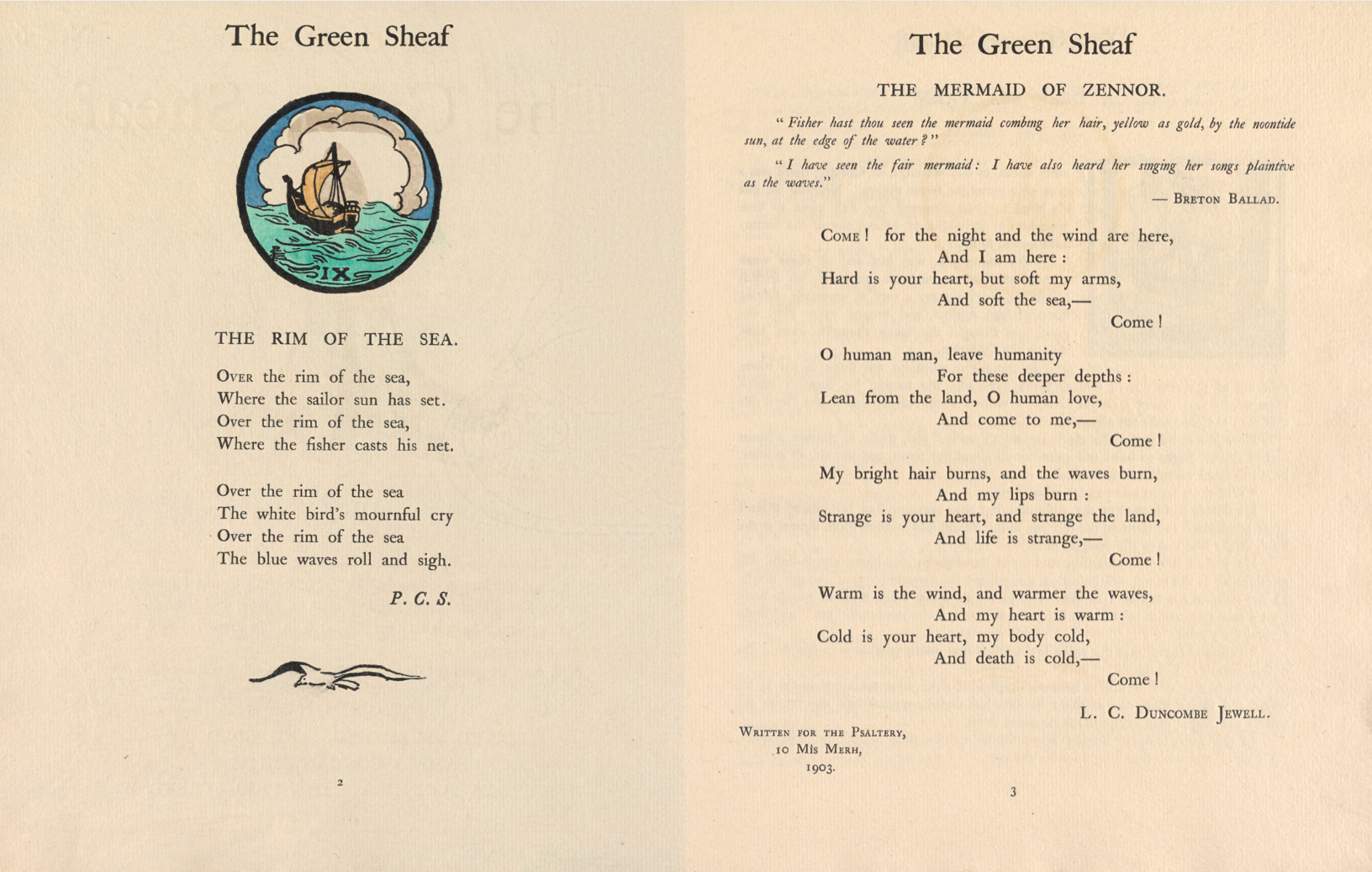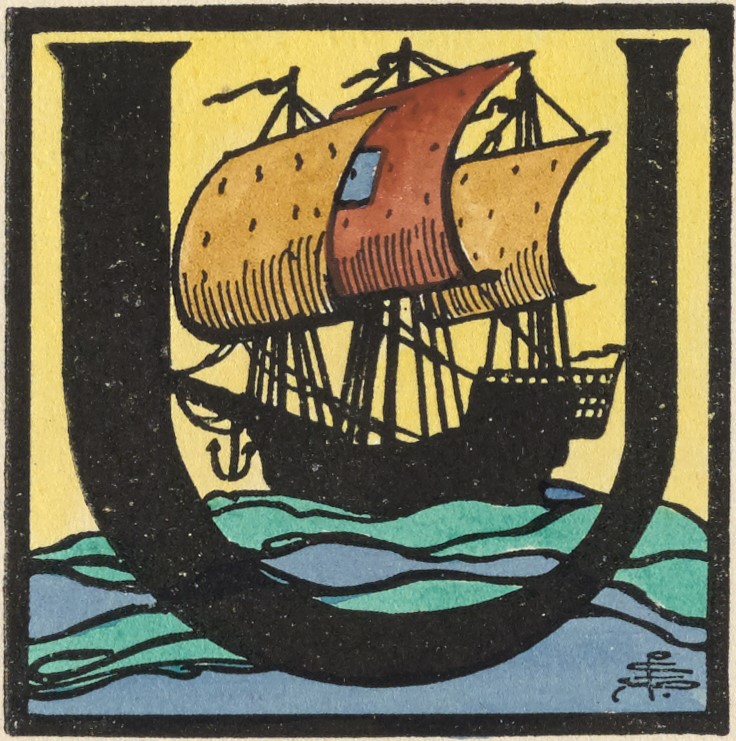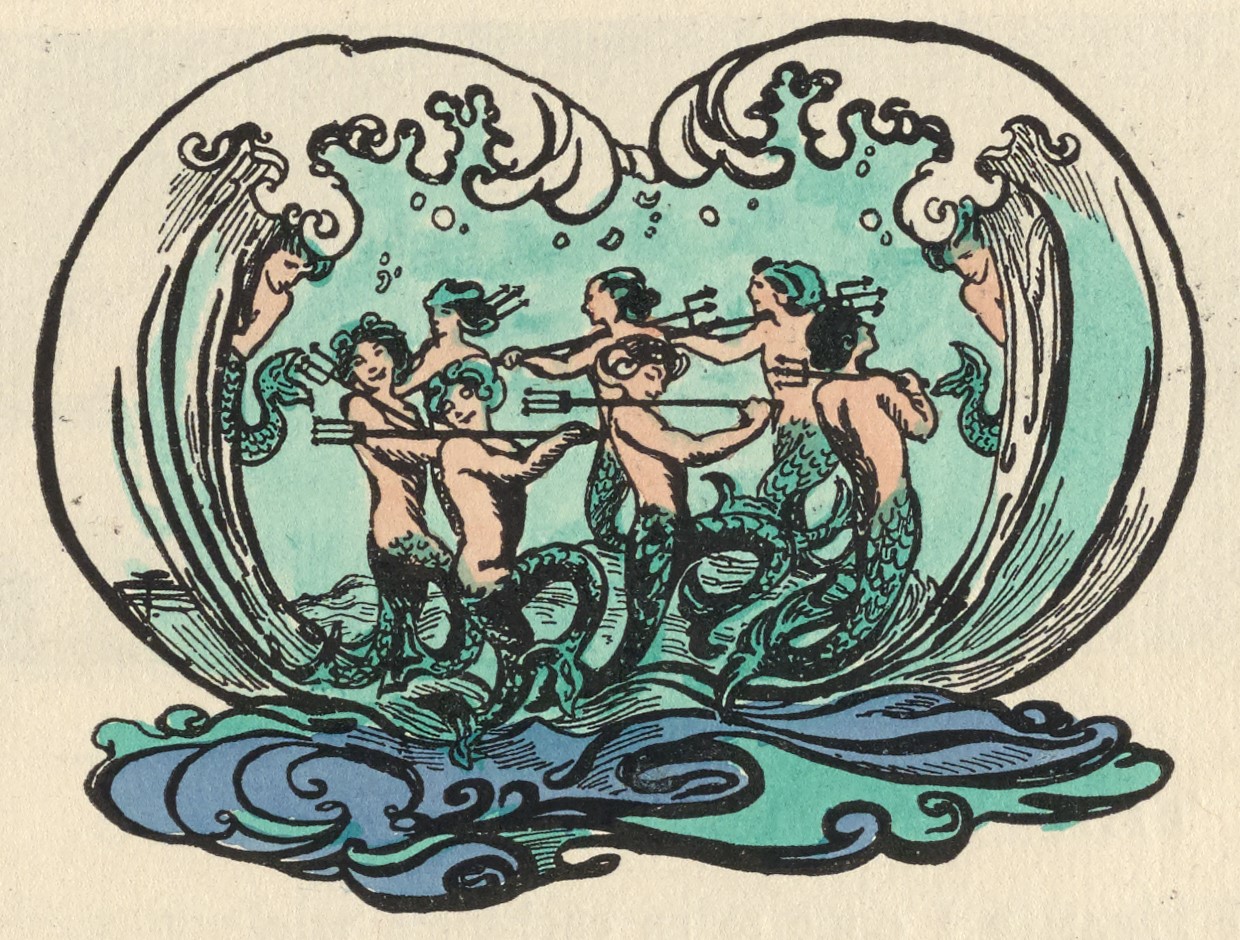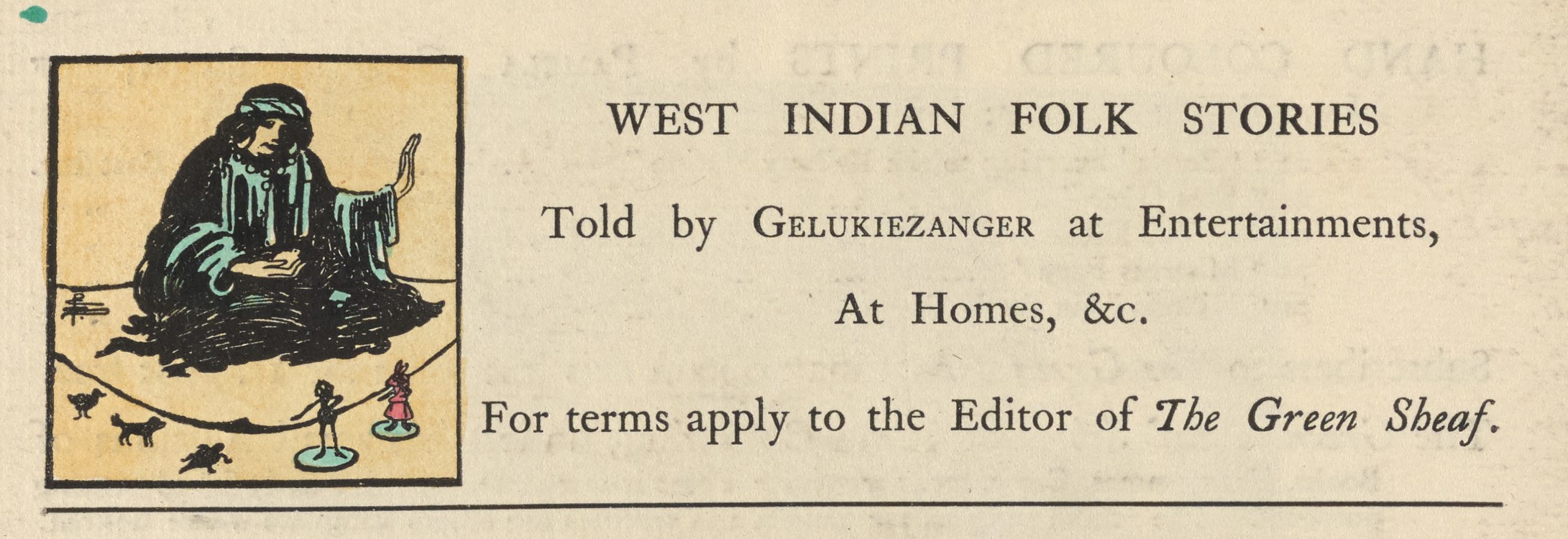XML PDF
Critical Introduction to The Green Sheaf
No. 6, 1903

To express the themes of The Green Sheaf’s sixth number, Pamela Colman Smith (1878-1951) works with a palette of pigments evoking sea, sand, and shell, offset with warm earth tones of mustard and sienna (fig. 1). Although Elizabeth O’Connor calls this the “Pirate Issue” of the magazine (162), there are no buccaneers in the number. Instead, the contents flow with watery tropes associated with mortality, the sea, and the supernatural. These themes are further linked through The Green Sheaf’s ongoing interests in liminality—the edges of sea and horizon, life and death, matter and spirit—and performance.
The issue’s contents include six poems, an excerpt from a play, a short story, and eight images, with two of its sixteen pages devoted to advertisements. For the first time in The Green Sheaf’s print run, only one of the issue’s eight writers and four artists is Irish: regular contributor Cecil French (1879-1953). Rather than publishing the local-colour literature of the Irish Revival movement, Smith features work by her London-based contacts, particularly those in her theatrical networks. She also includes verses from two deceased English writers: Romantic poet John Keats (1795-1821) and early modern lyricist Thomas Campion (1567-1620). Celebrated for his court masques, Campion would have been well known to Smith and her fellow members in the newly formed Masquers Society, which was working throughout 1903 to revive the lapsed tradition of integrating poetry, music, and dance with visual spectacle. As part of this effort, W.B. Yeats (1865-1939) gave a series of lectures that year on combining music and poetry, which actress Florence Farr (1860-1917) illustrated with rhythmic speech accompanied by the Celtic psaltery, and Smith illustrated with “lilting,” or a cappella chanting (Schuchard 129).

Smith sets the keynote for the issue’s themes in the first double-page spread, which features her own self-illustrated poem, “The Rim of the Sea” on the verso and “The Mermaid of Zennor” by Louis Charles Duncombe-Jewell (1866-1947) on the recto (fig. 2). Her headpiece illustration offers a circular image of a clipper ship on the waves, as if seen through a sailor’s telescope. The picture recalls the hand-coloured illustration for a poem about Jamaican privateer Henry Morgan that Smith had published in the April number of A Broad Sheet the previous year (O’Connor 162; Smith, Untitled). Unanchored to pirate lore in The Green Sheaf’s sixth number, the image relates more broadly to the “tales of …the sea” promised in the magazine’s manifesto (Smith, Front Cover). Smith uses a variation of this telescopic scene in her pictorial initial for John Masefield’s “A Deep Sea Yarn,” which appears in the next double-page opening (fig. 3). The opening poem conveys Smith’s interests in both liminal edges and performative chanting: repeating “Over the rim of the sea” four times in eight lines, the two-stanza lyric captures the rolling rhythms of the surf and would have been an apt piece for “lilting” recitation.

L.C. Duncombe-Jewell’s “The Mermaid of Zennor” on the facing page similarly connects with contemporary efforts to revive the bardic arts. A note below the verses indicates that Duncombe-Jewell’s work was “Written for the Psaltery”: in other words, the musical ballad was intended for oral performance accompanied by a traditional Celtic bowed instrument. A writer working to establish Cornwall’s Celtic culture (Husk and Williams 255), Duncombe-Jewell was interested in preserving Cornish ballads. His Green Sheaf offering conveys a traditional tale about a mermaid who entices a church chorister into the sea with her beautiful singing. Some of the imaginary field evoked by this mythical oceanic creature reappears in Smith’s illustration for Campion’s “Hymn in Praise of Neptune,” where the circle of “Tritons dancing in a ring” are overseen by curious mermaids, or “Syrens” of the sea (fig. 4; Campion 13).

Tropes of the sea, the supernatural, and death are developed at length by John Masefield (1878-1967) in the issue’s principal story, “A Deep Sea Yarn.” Masefield had previously contributed to The Green Sheaf’s second number along with his friends J. M. Synge (1871-1901) and W. B. Yeats (see Critical Introduction to The Green Sheaf, No. 2). A celebrated poet and storyteller who began his career as a sailor and ended it as Britain’s poet laureate, Masefield was known for the nautical themes in his work. In addition to his experiences on board ship, Masefield credited the musical chanting, verse-speaking, and innovative theatre experiments of Yeats and others in the Irish Literary Movement as influential in his own storytelling (Ryan 150). He was especially inspired by Yeats’s lectures on chanting, which Pamela Colman Smith demonstrated with her “lilting” performances (Schuchard 137). Masefield’s “A Deep Sea Yarn” relays the tale of a man who, having hit bottom in his life, sells his soul to the Devil in exchange for twenty years of prosperity and happiness. Fearing for his life near the end of this term, he tries to escape his fate by signing on as an Able Boatman (A.B.) aboard a clipper ship bound for China. Most of this long story—at six pages, the longest item in The Green Sheaf’s entire print run—details the way in which the ship’s clever captain outwits the Black Fiend and saves the life of the unfortunate sailor.
To take the issue’s tropes of death and the sea in a different direction, Smith includes a brief extract from an English translation of The Good Hope: A Sea Play (1900), by Dutch naturalist playwright Herman Heijermans (1864-1924). A searing indictment of the capitalist exploitation of impoverished fisher folk, the play was highly regarded in Smith’s theatrical circle. Christopher St. John (aka Christabel Marshall, 1871-1960) translated Heijermans’ play and her partner Edith Craig (1869-1947) stage-managed its production, when the latter’s mother Ellen Terry (1847-1928) took it on tour in 1903-1904 (Cockin 78). Smith made a wash drawing of Terry as the widow Knier and may have designed the actress’s costume for the production (Smith, “Dame Ellen Terry”). Smith did not include this drawing, however, among the “Hand-Coloured Prints by Pamela Colman Smith, of Miss Ellen Terry” in various roles, which she advertised in issues four through eleven of The Green Sheaf (Advertisements 15). “Cobus on Death,” the extract she selected from St. John’s translation of Heijermans’ play for The Green Sheaf, articulates a resigned acceptance of the inevitability of death at sea—“We take the fish, and God takes us” (St. John 12). This attitude stands in sharp contrast to Masefield’s fantastic tale of avoiding (or at least deferring) death by tricking fate in the form of the Devil. Supporting the issue’s exploration of liminal edges, the dramatic dialogue concludes with Cobus’s dismissal of the fear of death: “To be frightened is nothing. . . to be frightened only means you’ve stood on tiptoe and looked over the edge…” (ibid.). Smith balances this existential outlook with Campion’s celebration of the elemental power of “Neptune’s empire” on the facing page (13).

Two illustrated poems and a poetic extract with watery themes round out the contents of the sixth number. The fifth double-page opening displays “The Tidal River,” written and illustrated by Dorothy P. Ward (1899-1976), on the verso, and the first quatrain of John Keats’s sonnet “Bright Star,” illustrated by W. T. Horton (1864-1919), on the recto (fig. 5). Ward captures the ebb and flow of the tides in three quatrains formed by a series of questions set in long lines with falling rhythms and double rhymes; her headpiece illustration depicts a quiet harbour at twilight. In contrast to Ward’s realistic scene, Horton imagines Keats’s star as a spiritual figure watching over “The moving waters at their priest-like task” of cleansing “earth’s human shores” (Keats 11). As is usual in the reproduction of his work for The Green Sheaf, Horton’s image remains uncoloured. The artist favoured black-and-white art, as can be seen in another of his Keats illustrations, “Now more than ever seems it rich to die,” published in The Savoy (1896). Cecil French’s self-illustrated “The Waters of the Moon” appears as the final item before the advertising pages. Detailing a dream in which the speaker bathes in “magic wells” and meets his soul mate, the poem takes an erotically-charged spiritual approach to the issue’s watery themes.

This number’s advertisements are noteworthy for featuring Smith’s first promotion of her “for-hire” performances of “West Indian Folk Stories” at “Entertainments, At Homes, & c.” (Smith, Illustrated Advertisement, 16). The hand-coloured illustration accompanying the ad shows Smith seated cross-legged in her story-telling garb, with the small figures she created to accompany her performances ranged around her (fig. 6). Smith’s entrepreneurial story-telling combined her interest in performance with her need to earn money. In contrast to her publishing ventures, Smith enjoyed modest success as a performance artist. For some years after The Green Sheaf print run ended Smith continued to tell her stories about the Jamaican trickster Annancy at galleries and other venues in London and New York.
Marking the near-halfway point of its thirteen issues, The Green Sheaf’s sixth number suggests some of the strain editor-publisher Smith was under in making her monthly magazine a paying concern. By February of the following year, Smith admitted to a correspondent: “I am getting Annancy stories very often now and hope in time to make some money by it—The Green Sheaf does not pay yet—it is most discouraging to go on working at it” (qtd in Kaplan 55). In fall 1903, however, Smith remained committed to making her little magazine a transatlantic success. Signaling an effort to increase her readership, the next number would announce a new American-based distributor, the famed Brentano’s Literary Emporium in New York’s Union Square. Moreover, as the prospectus printed on the back page indicates, the seventh issue would return to more Irish-themed contents, with contributions by prominent members of the Literary Revival. Cecil French, A.E. (aka George Russell, 1867-1935), Alix Egerton (1870-1932), and John Todhunter (1839-1916), were to publish work in the next number (Advertisements 16). When Green Sheaf No. 7 came out, however, Todhunter’s promised contribution was not present; in fact, it would not appear until the ninth issue. As an editor of a little magazine whose monthly issues depended on contributors to supply material by publication deadlines, Smith often struggled to find sufficient contents for each number. It is not surprising, then, that as the print run progressed, the standard size of The Green Sheaf dwindled from sixteen to eight pages, sometimes augmented by supplements.
©2022 Lorraine Janzen Kooistra, FRSC, Emerita Professor of English and Senior Research Fellow, Centre for Digital Humanities, Toronto Metropolitan University
Works Cited
- Advertisements. The Green Sheaf, No. 6, 1903, pp. 15-16. Green Sheaf Digital Edition, edited by Lorraine Janzen Kooistra. Yellow Nineties 2.0, Toronto Metropolitan University Centre for Digital Humanities, 2022. https://1890s.ca/GSV6-ads/
- Campion, Thomas. “A Hymn in Praise of Neptune,” illustrated by Pamela Colman Smith. The Green Sheaf, No. 6, 1903, p. 13. Green Sheaf Digital Edition, edited by Lorraine Janzen Kooistra, Yellow Nineties 2.0, Toronto Metropolitan University Centre for Digital Humanities, 2022. https://1890s.ca/GSV6-campion-neptune/Cockin, Katharine. Edith Craig and the Theatres of Art, Bloomsbury 2017.
- Duncombe-Jewell, L.C. “The Mermaid of Zennor.” The Green Sheaf, No. 6, 1903, p. 3. Green Sheaf Digital Edition, edited by Lorraine Janzen Kooistra, Yellow Nineties 2.0, Toronto Metropolitan University Centre for Digital Humanities, 2022. https://1890s.ca/GSV6-duncombe-jewell-mermaid/
- French, Cecil. “The Waters of the Moon,” illustrated by Cecil French. The Green Sheaf, No. 6, 1903, p. 14. Green Sheaf Digital Edition, edited by Lorraine Janzen Kooistra, Yellow Nineties 2.0, Toronto Metropolitan University Centre for Digital Humanities, 2022. https://1890s.ca/GSV6-french-waters/
- Horton, W.T. “‘Now more than ever seems it rich to die, /To cease upon the midnight with no pain.’ After a Pen-and-Ink Sketch.” The Savoy, vol. 7, November 1896, p. 39. Savoy Digital Edition, edited by Christopher Keep and Lorraine Janzen Kooistra, Yellow Nineties 2.0, Toronto Metropolitan University Centre for Digital Humanities, 2019, https://1890s.ca/savoyv7_horton_sketch/
- —. Illustration for Untitled [from “Bright Star”], by John Keats. The Green Sheaf, No. 6, 1903, p. 11. Green Sheaf Digital Edition, edited by Lorraine Janzen Kooistra, Yellow Nineties 2.0, Toronto Metropolitan University Centre for Digital Humanities, 2022. https://1890s.ca/GSV6-keats-bright-star/
- Husk, Kerryn and Malcolm Williams. “The Legitimation of Ethnicity: The Case of the Cornish.” Studies in Ethnicity and Nationalism, vol 12, no. 2, 2021, pp. 249-267.
- Kaplan, Stuart R, with Mary K. Greer, Elizabeth Foley O’Connor, and Melinda Boyd Parsons. Pamela Colman Smith: The Untold Story. U.S. Games Systems, 2018.
- Keats, John. Untitled [from “Bright Star”], illustrated by W. T. Horton. The Green Sheaf, No. 6, 1903, p. 11. Green Sheaf Digital Edition, edited by Lorraine Janzen Kooistra, Yellow Nineties 2.0, Toronto Metropolitan University Centre for Digital Humanities, 2022. https://1890s.ca/GSV6-keats-bright-star/
- Masefield, John. “A Deep Sea Yarn,” pictorial initial by Pamela Colman Smith. The Green Sheaf, No. 6, 1903, pp. 4-9. Green Sheaf Digital Edition, edited by Lorraine Janzen Kooistra, Yellow Nineties 2.0, Toronto Metropolitan University Centre for Digital Humanities, 2022. https://1890s.ca/GSV6-masefield-yarn/
- O’Connor, Elizabeth. “Pamela Colman Smith’s Performative Primitivism.” Caribbean Irish Connections: Interdisciplinary Perspectives, edited by Alison Donnell, Maria McGarrity, and Evelyn O’Callaghan, University of the West Indies, 2015, pp. 157-173.
- Ryan, Patrick. “The Discovery of Storytelling and the Part of Overlooked Poets, Players and Librarians.” Books 2.0, vol. 7, no. 2, 2017, pp. 145-157.
- St John, Christopher, trans. “Cobus on Death,” by H. Heijermans. The Green Sheaf, No. 6, 1903, p. 12. Green Sheaf Digital Edition, edited by Lorraine Janzen Kooistra, Yellow Nineties 2.0, Toronto Metropolitan University Centre for Digital Humanities, 2022. https://1890s.ca/GSV6-heijermans-cobus/
- Schuchard, Ronald. The Last Minstrels: Yeats and the Revival of the Bardic Arts. Oxford University Press, 2010.
- Smith, Pamela Colman. “Dame Ellen Terry (1847-1928) in ‘The Good Hope’ by H. Heijermans,” Engraved Print, 1904. Smallhythe Place, Kent. https://www.nationaltrustcollections.org.uk/object/1118438
- —. Front Cover. The Green Sheaf, vol. 6, 1903, [i]. Green Sheaf Digital Edition, edited by Lorraine Janzen Kooistra, Yellow Nineties 2.0, Toronto Metropolitan University Centre for Digital Humanities, 2022. https://1890s.ca/GSV6-smith-front-cover/
- —. Illustrated Advertisement for West Indian Stories Told by Gelukiezanger. The Green Sheaf, No. 6, 1903, p. 16. Green Sheaf Digital Edition, edited by Lorraine Janzen Kooistra, Yellow Nineties 2.0, Toronto Metropolitan University Centre for Digital Humanities, 2022. https://1890s.ca/GSV6-smith-folk-ad/
- —. Illustration for “A Hymn in Praise of Neptune,” by Pamela Thomas Campion. The Green Sheaf, No. 6, 1903, p. 13. Green Sheaf Digital Edition, edited by Lorraine Janzen Kooistra, Yellow Nineties 2.0, Toronto Metropolitan University Centre for Digital Humanities, 2022. https://1890s.ca/GSV6-smith-neptune-headpiece/
- —. Pictorial Initial for “A Deep Sea Yarn,” by John Masefield. The Green Sheaf, No. 6, 1903, p. 4. Green Sheaf Digital Edition, edited by Lorraine Janzen Kooistra, Yellow Nineties 2.0, Toronto Metropolitan University Centre for Digital Humanities, 2022. https://ornament.library.torontomu.ca/items/show/199
- —. “The Rim of the Sea,” illustrated and decorated by Pamela Colman Smith, The Green Sheaf, No. 6, 1903, p. 2. Green Sheaf Digital Edition, edited by Lorraine Janzen Kooistra, Yellow Nineties 2.0, Toronto Metropolitan University Centre for Digital Humanities, 2022. https://1890s.ca/GSV6-smith-sea/
- —. Untitled. [“The merry wind”], illustrated by Pamela Colman Smith. A Broad Sheet, no. 4, April 1902. Walter and Martha Leuba Collection, University of Pittsburgh, https://digital.library.pitt.edu/islandora/object/pitt%3Awmlp0059
- Ward, Dorothy. “The Tidal River,” illustrated by Dorothy Ward. The Green Sheaf, No. 6, 1903, p. 10. Green Sheaf Digital Edition, edited by Lorraine Janzen Kooistra, Yellow Nineties 2.0, Toronto Metropolitan University Centre for Digital Humanities, 2022. https://1890s.ca/GSV6-ward-river/
MLA citation: Kooistra, Lorraine Janzen. “Critical Introduction to The Green Sheaf No. 6, 1903.” Green Sheaf Digital Edition, Yellow Nineties 2.0, edited by
Lorraine Janzen Kooistra, Toronto Metropolitan University Centre for Digital Humanities,
2023. https://1890s.ca/gsv6_introduction/.